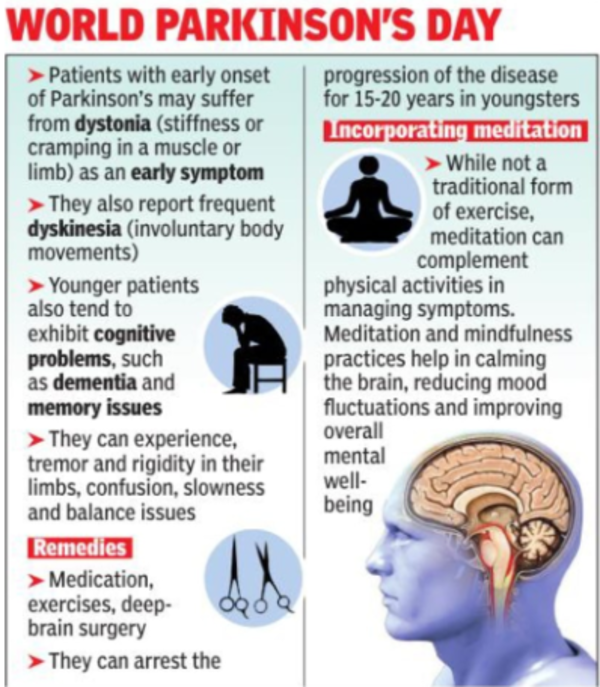- News
- City News
- kolkata News
- 10% of Kolkata’s Parkinson’s patients aged below 40
Trending
10% of Kolkata’s Parkinson’s patients aged below 40
10% of Kolkata's Parkinson’s patients are under 40, diagnosed young, facing job insecurity. Genetic factors contribute, exercise is crucial. Deep brain stimulation is less viable due to cost, leaving medication and exercise as primary options for the young working population.

Representative image
KOLKATA: A growing number of Parkinson’s disease patients in Kolkata are being diagnosed at a younger age, with around 10% of them now below the age of 40 and still part of the workforce.
This early onset of Parkinson’s is a serious concern, according to neurologists. Many of these young patients are losing their jobs due to employers’ lack of trust in their abilities or their inability to earn enough to support their treatment, experts pointed out on World Parkinson’s Day on Thursday.

Despite the fact that early detection and treatment can slow the progression of the disease, allowing patients to lead normal lives, their fitness is often judged based on their symptoms. A 35-year-old investment banker, diagnosed with Parkinson’s last year, has been put on notice by his employers who doubt his ability to continue working, even though his neurologist believes he is capable of working 10 hours a day. Similarly, a 31-year-old chartered accountant is not being given any responsibility in his auditing team ever since he has been diagnosed with Parkinson’s. He now fears losing his job.
Sinjan Ghosh, consultant neurologist at Fortis Hospital, states that the number of young patients has increased significantly over the last decade. On an average, 20% of his monthly patients have Parkinson’s disease, with 90% being older (above 60) and 10% being younger. Younger patients often have a genetic predisposition, hereditary Parkinson’s disease, or develop vascular Parkinsonism after a stroke.
Both Kumar and Ghosh agree that exercise, along with medication, is the best option for limiting the progression of the disease and maintaining an active lifestyle. Those who exercise find it easier to have a normal working life. Long-term benefits of exercise include improved heart health, increased blood flow to the brain, and the promotion of neuroplasticity, which is crucial in slowing down brain degeneration associated with Parkinson’s.
While deep brain stimulation (DBS) surgery or implanting a brain pacemaker is another long-term option for managing Parkinson’s, its high cost makes it difficult for many. For the young working population, medication and exercise remain the most viable options.
This early onset of Parkinson’s is a serious concern, according to neurologists. Many of these young patients are losing their jobs due to employers’ lack of trust in their abilities or their inability to earn enough to support their treatment, experts pointed out on World Parkinson’s Day on Thursday.

Despite the fact that early detection and treatment can slow the progression of the disease, allowing patients to lead normal lives, their fitness is often judged based on their symptoms. A 35-year-old investment banker, diagnosed with Parkinson’s last year, has been put on notice by his employers who doubt his ability to continue working, even though his neurologist believes he is capable of working 10 hours a day. Similarly, a 31-year-old chartered accountant is not being given any responsibility in his auditing team ever since he has been diagnosed with Parkinson’s. He now fears losing his job.
Hrishikesh Kumar, head of neurology and vice-president at the Institute of Neurosciences Kolkata (INK), suggests that a complex interplay of genetic factors, pollution and lifestyle could be responsible for the early onset of Parkinson’s. “The initial symptoms are tremor and difficulty in limb movement. So, most youngsters seek treatment early but since it has no cure, one has to learn to live with it. With medication and exercises, Parkinson’s can be checked and the patient can have a normal, working life. Unfortunately, the symptoms are so apparent and disconcerting that both patients and those around them find it difficult to accept them. Most young patients improve with medication and can return to work. But many end up losing their jobs,” said Kumar. He notes that out of the 25 Parkinson’s patients he sees daily, around four to five are below 40 years.
Sinjan Ghosh, consultant neurologist at Fortis Hospital, states that the number of young patients has increased significantly over the last decade. On an average, 20% of his monthly patients have Parkinson’s disease, with 90% being older (above 60) and 10% being younger. Younger patients often have a genetic predisposition, hereditary Parkinson’s disease, or develop vascular Parkinsonism after a stroke.
Both Kumar and Ghosh agree that exercise, along with medication, is the best option for limiting the progression of the disease and maintaining an active lifestyle. Those who exercise find it easier to have a normal working life. Long-term benefits of exercise include improved heart health, increased blood flow to the brain, and the promotion of neuroplasticity, which is crucial in slowing down brain degeneration associated with Parkinson’s.
While deep brain stimulation (DBS) surgery or implanting a brain pacemaker is another long-term option for managing Parkinson’s, its high cost makes it difficult for many. For the young working population, medication and exercise remain the most viable options.
End of Article
FOLLOW US ON SOCIAL MEDIA










